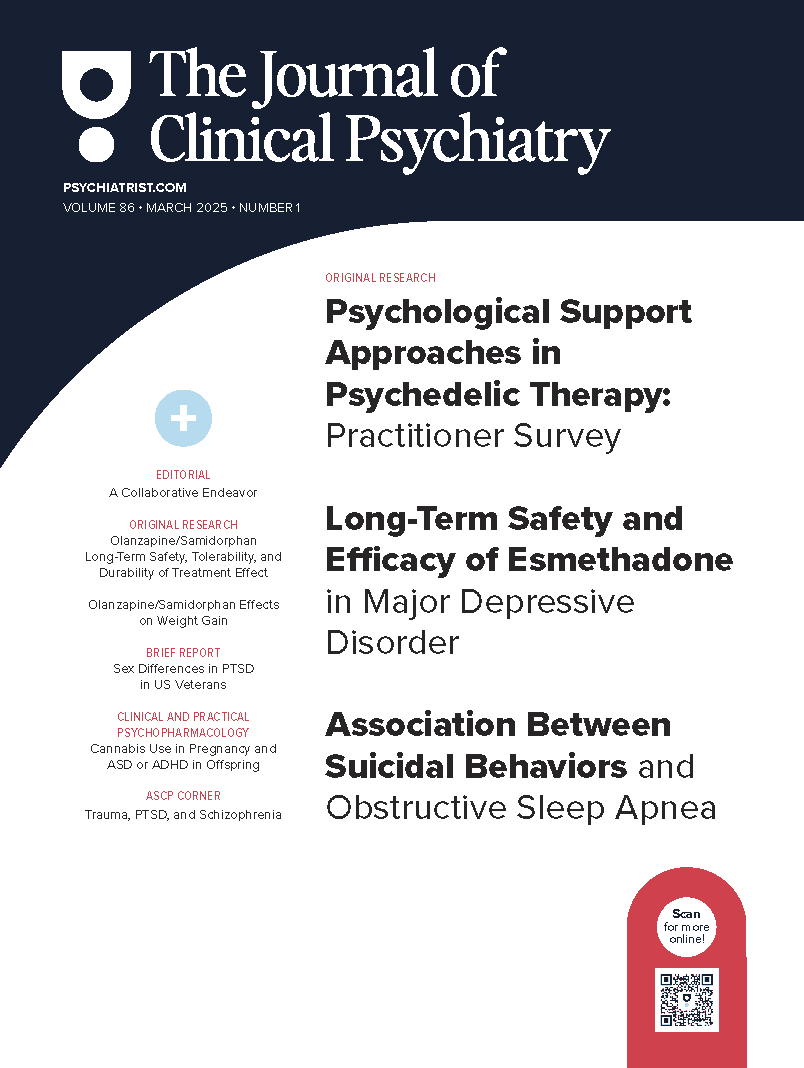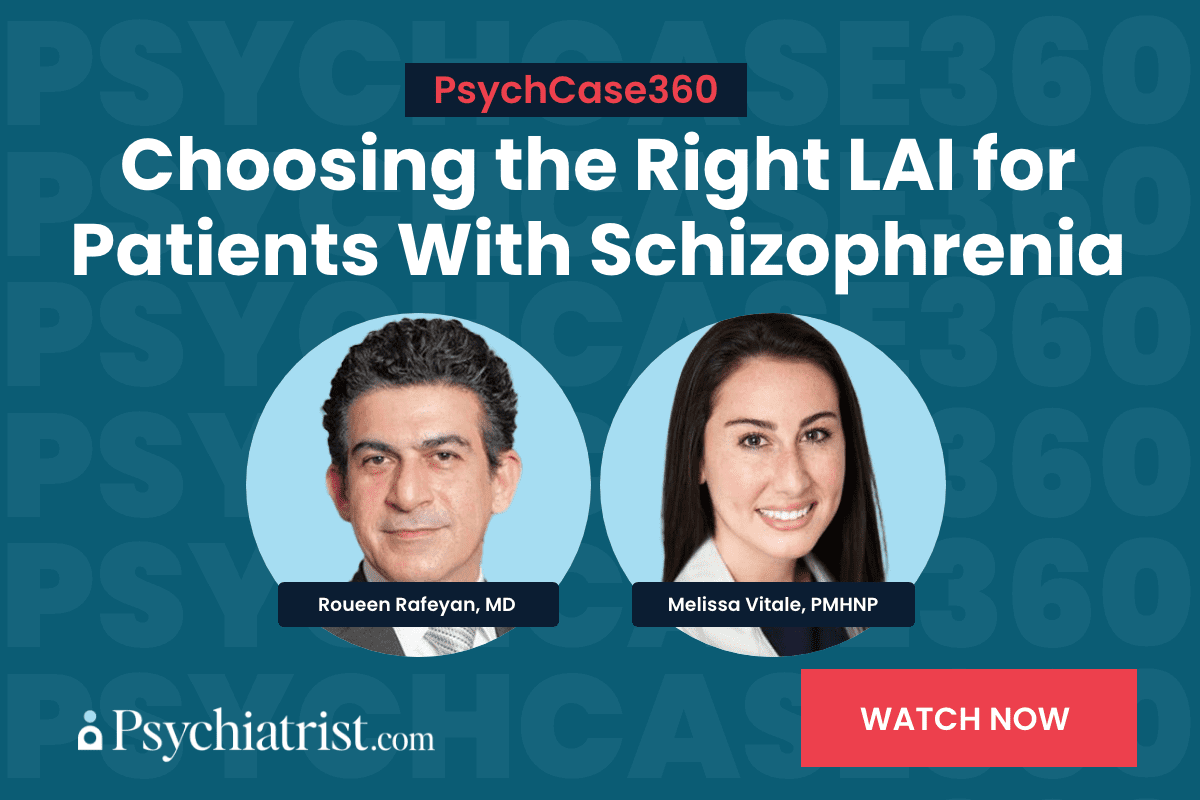See articles by Sibley et al and Brynte et al.
Here, we consider recent publications in the Journal of Clinical Psychiatry that characterize the progression of attention-deficit/hyperactivity disorder (ADHD) into young adulthood and document that adults with substance use disorders and ADHD experience variable care approaches. Morbidity of adult ADHD in the US has been recognized as a major public health concern,1 and increased demand for stimulant treatments used for ADHD2 has brought heightened attention to the importance of clarifying best ADHD evaluation and treatment practices.3–5
While studies demonstrate that ADHD persists beyond childhood in a majority of individuals,6 follow-up to the Multimodal Treatment of ADHD (MTA) study into adulthood presents ADHD as having a variable course over time.7 As reported in a recent issue of JCP, between elementary school and early adult years, ADHD burden fluctuated in most of a sample of well-characterized MTA participants who had persistent ADHD.8 This finding would suggest that absence of prior ADHD symptoms does not negate need for ongoing vigilance and raises the question of what length of time ADHD-free should define remission.
The recent MTA analysis found that over time environmental demand, defined as number of major life roles, correlated with lower burden of ADHD, particularly during the transition to adulthood. The greater number of roles that a teenager or young adult had among studying, working, parenting, or living independently, the lower their ADHD burden was. Future research could confirm whether risk of ADHD fluctuation continues beyond young adult years.
While individuals with less ADHD burden may be more capable of participating in more life roles, there may be a common mediator between role participation and ADHD mitigation: salience. Salience refers to the noticeability or importance of a cue or context. Stimulant treatment may reduce ADHD by increasing the salience of tasks,9 and so too environments rich in incentivizing stimuli may be easier to engage. A correlated question arises as to how our treatments can be tailored to increase salience for individuals with ADHD. Individuals with executive function challenges often use the word “structure” to describe environmental attributes that facilitate productive habits. A number of self-structuring methods are commonly used, which one study of college students highlighted includes working up against deadlines, working in time blocks with planned breaks, and reformatting learning materials.10 Coworking with other people at a distance, sometimes complete strangers over the internet, has also become a recommended environmental-modification productivity tool.11 The limited research to date on the impact of environmental modification for ADHD has primarily evaluated the impact of distraction management or extended time on evaluations.12
Clinicians can recognize the role of salience and help individuals with ADHD work to modify the salience of their tasks and activities. For example, cognitive behavioral therapy may empower individuals to modify salience, by training them to orient on the benefits of an effort rather than the onerous qualities of tasks. Training and counseling of individuals with ADHD may benefit from research identifying successful salience-enhancing behaviors. Studies targeting salience modification could also lead to new pharmacotherapy and behavioral therapy interventions.
The report also found some predictors of persistence of ADHD: mental health burden in childhood, substance use in adolescent years, and lack of initial treatment response during the MTA study. This is consistent with prior work demonstrating that childhood ADHD severity predicts future morbidity and clinical complexity.13 The second report we consider, from the current issue of this journal, explores the treatment choices made when adults with ADHD present with a specific form of clinical complexity: substance use disorders.14 In 10 international specialty clinics, within the first month 40% of individuals (mean age, 36.7 years) were treated with a stimulant medication and 25% received a combination of psychopharmacology and psychotherapy.14 Clinicians may consider many factors in treatment decision-making, but this study found that the study clinic involved contributed more than active substance use, polysubstance use, comorbidity, ADHD symptom severity, or sociodemographic factors. Where individuals were abstinent from substances of misuse, had higher ADHD symptom burden, and had worse overall health, they were more likely to receive a form of ADHD treatment. The variability of approach across sites is noteworthy particularly because this report comes from a consortium of clinics with both ADHD psychotherapy and psychopharmacology resources, and international guidelines for treatment of SUD and ADHD have been established.15,16
Treatment of adolescents and adults with ADHD and SUD is evolving. For instance, retrospective evidence suggests that ADHD treatment intersects favorably with SUD outcomes. Several reports also highlight that ADHD pharmacotherapy may improve retention in SUD treatments,17–20 which represents a major predictor of successful outcome for SUD. Previously, it had been thought that abstinence should be established for an undetermined amount of time prior to initiating medication therapy. More recent guidelines and consensus statements suggest that individuals in treatment for SUD should be evaluated and treated for their ADHD concurrent with their SUD treatment, based on clinical trials and real-world experience. In adolescents and young adults, motivational interviewing and cognitive behavioral therapy have been recommended for this comorbid presentation.21 The value of combining psychotherapy and psychopharmacology in individuals with SUD and ADHD is another important area of research interest.22
Nonstimulant treatments and preferential use of prodrug and/or extended-release preparations of stimulants may be more appropriate where substance misuse is a concern. Data from pilot clinical trials have begun to explore the safety of ADHD pharmacotherapy in alcohol, marijuana, stimulant, and opiate use disorders.23–26 Of note, however, many of these same studies suggest that when using stimulants, higher dosing may be required for those with current, active SUD compared to non-SUD samples of ADHD.27,28
The two articles we consider highlight that the manifestation of ADHD can be heavily influenced by context, as well as individual vulnerabilities and strengths. Future prospective research could improve our understanding of how patient specific historical factors, such as pattern of ADHD burden over time and comorbid conditions including SUD, should inform personalized treatment recommendations. In a strained ADHD-care environment, efficient use of resources and public health protection are important goals.5 Effective systems of care for individuals with ADHD would accommodate the underlying vulnerability that the condition creates and recognize that treating ADHD itself may directly impact participation in care.
AnchorArticle Information
Published Online: December 23, 2024. https://doi.org/10.4088/JCP.24com15705
© 2024 Physicians Postgraduate Press, Inc.
J Clin Psychiatry 2025;86(1):24com15705
Submitted: November 11, 2024; accepted November 13, 2024.
To Cite: Surman C, Wilens T. Fluctuating impairment and complex presentations: evolving care and research priorities in ADHD. J Clin Psychiatry. 2025;86(1):24com15705.
Author Affiliations: Clinical and Research Program in Adult ADHD, Massachusetts General Hospital, Harvard Medical School, Boston, Massachusetts (Surman); Department of Psychiatry, Massachusetts General Hospital, Harvard Medical School, Boston, Massachusetts (Wilens).
Corresponding Author: Craig Surman, Department of Psychiatry, MD, 55 Fruit St, Warren 625, Boston, MA 02114 (csurman@mgh.harvard.edu).
Relevant Financial Relationships: In the past 2 years, Dr Surman has received support for research at Massachusetts General Hospital by Pharmopatheca; consulting fees from Kayuna, Ironshore, Neurocentria, Supernus; and royalties from Berkeley/Penguin and from Humana/Springer, and he is an employee of Massachusetts General Hospital. In the past 2 years, Dr Wilens reports grant/research support for research from National Institutes of Health/National Institute on Drug Abuse and Ironshore; royalties from Cambridge University Press, Elsevier, Ironshore, and Guilford Press; fees for clinical consulting from the Gavin Foundation, Bay Cove Human Services, the US National Football League (ERM Associates), US Minor/Major League Baseball, and White Rhino/3D. He is an employee of Massachusetts General Hospital and serves as co-editor of publications by Elsevier.
Funding/Support: None.
References (28)

- Staley BS, Robinson LR, Claussen AH, Katz SM. Attention-deficit/hyperactivity disorder diagnosis, treatment, and telehealth use in adults – National Center for Health Statistics Rapid Surveys System, United States, October–November 2023. MMWR. 2024;73(40):890–895. CrossRef
- Sibley MH, Faraone SV, Nigg JT, et al. Sudden increases in U.S. stimulant prescribing: alarming or not? J Atten Disord. 2023;27(6):571–574. CrossRef
- Faraone SV, Silverstein MJ, Antshel K, et al. The adult ADHD quality measures initiative. J Atten Disord. 2019;23(10):1063–1078. PubMed CrossRef
- National Academies of Sciences, Engineering, and Medicine; Health and Medicine Division; Board on Health Sciences Policy; Forum on Neuroscience and Nervous System Disorders; Forum on Drug Discovery, Development, and Translation. Shore C, Posey Norris SM, Berkower C, eds, et al. Adult Attention Deficit/ Hyperactivity Disorder: Diagnosis, Treatment, and Implications for Drug Development: Proceedings of a Workshop. The National Academies Press; 2024.
- Blanco C, Surman CBH. Diagnosing and treating ADHD in adults: balancing individual benefits and population risks. JAMA Psychiatry. Published online October 24, 2024. doi:10.1001/jamapsychiatry. 2024.3228 PubMed CrossRef
- Cherkasova MV, Roy A, Molina BSG, et al. Review: adult outcome as seen through controlled prospective follow-up studies of children with attention-deficit/ hyperactivity disorder followed into adulthood. J Am Acad Child Adolesc Psychiatry. 2022;61(3):378–391. CrossRef
- Sibley MH, Arnold LE, Swanson JM, et al. Variable patterns of remission from ADHD in the Multimodal Treatment Study of ADHD. Am J Psychiatry. 2022;179(2):142–151. CrossRef
- Sibley MH, Kennedy TM, Swanson JM, et al. Characteristics and predictors of fluctuating attention deficit/hyperactivity disorder in the Multimodal Treatment of ADHD (MTA) study. J Clin Psychiatry. 2024;85(4):24m15395. PubMed
- Volkow ND, Wang GJ, Fowler JS, et al. Evidence that methylphenidate enhances the saliency of a mathematical task by increasing dopamine in the human brain. Am J Psychiatry. 2004;161(7):1173–1180. PubMed CrossRef
- Kreider CM, Medina S, Slamka MR. Strategies for coping with time-related and productivity challenges of young people with learning disabilities and attention-deficit/hyperactivity disorder. Child. 2019;6(2):28. CrossRef
- Ables K. “Body doubling,” an ADHD productivity tool, is flourishing online. Washington Post. Published June 2022. Accessed November 8, 2024. https://www.washingtonpost.com/wellness/2022/06/01/virtualbody-doubling-productivity-tiktok/
- Lovett BJ, Nelson JM. Systematic review: educational accommodations for children and adolescents with attention-deficit/hyperactivity disorder. J Am Acad Child Adolesc Psychiatry. 2021;60(4):448–457. CrossRef
- Caye A, Swanson J, Thapar A, et al. Life span studies of ADHD-conceptual challenges and predictors of persistence and outcome. Curr Psychiatry Rep. 2016;18(12):111. PubMed CrossRef
- Brynte C, Schellekens A, Barta C, et al. Treatments and treatment predictors in patients with substance use disorders and comorbid attention deficit/hyperactivity disorder: first results from the International Naturalistic Cohort Study of ADHD and SUD (INCAS). J Clin Psychiatry. 2025;86(1):24m15494.
- Özgen H, Spijkerman R, Noack M, et al. International consensus statement for the screening, diagnosis, and treatment of adolescents with concurrent attention-deficit/hyperactivity disorder and substance use disorder. Eur Addict Res. 2020;26(4–5):223–232. CrossRef
- Krinzinger H, Hall CL, Groom MJ, et al. Neurological and psychiatric adverse effects of long-term methylphenidate treatment in ADHD: a map of the current evidence. Neurosci Biobehav Rev. 2019;107:945–968. CrossRef
- Kast KA, Rao V, Wilens TE. Pharmacotherapy for attention-deficit/hyperactivity disorder and retention in outpatient substance use disorder treatment: a retrospective cohort study. J Clin Psychiatry. 2021;82(2):20m13598. PubMed
- Xu KY, Berkel TDM, Martin CE, et al. Prescription psychostimulant use, admissions and treatment initiation and retention in pregnant people with opioid use disorder. Nat Ment Health. 2024;2:801–808. CrossRef
- Mintz CM, Xu KY, Presnall NJ, et al. Analysis of stimulant prescriptions and drug-related poisoning risk among persons receiving buprenorphine treatment for opioid use disorder. JAMA Netw Open. 2022;5(5):e2211634. CrossRef
- Tardelli V, Xu KY, Bisaga A, et al. Prescription amphetamines in people with opioid use disorder and co-occurring psychostimulant use disorder initiating buprenorphine: an analysis of treatment retention and overdose risk. BMJ Ment Health. 2023;26(1):e300728. CrossRef
- Zulauf CA, Sprich SE, Safren SA, et al. The complicated relationship between attention deficit/ hyperactivity disorder and substance use disorders. Curr Psychiatry Rep. 2014;16(3):436. PubMed CrossRef
- Riggs PD, Winhusen T, Davies RD, et al. Randomized controlled trial of osmotic-release methylphenidate with cognitive-behavioral therapy in adolescents with attention-deficit/hyperactivity disorder and substance use disorders. J Am Acad Child Adolesc Psychiatry. 2011;50(9):903–914. PubMed CrossRef
- Wilens TE, Adler LA, Weiss MD, et al. Atomoxetine treatment of adults with ADHD and comorbid alcohol use disorders. Drug Alcohol Depend. 2008;96(1–2):145–154. CrossRef
- McRae-Clark AL, Carter RE, Killeen TK, et al. A placebo-controlled trial of atomoxetine in marijuana dependent individuals with attention deficit hyperactivity disorder. Am J Addict. 2010;19(6):481–489. PubMed CrossRef
- Park TW, Baul TD, Morgan JR, et al. Trends in attention-deficit hyperactivity disorder diagnosis and pharmacotherapy among adults with opioid use disorder. Psychiatr Serv. 2024;75(3):214–220. CrossRef
- Barbuti M, Maiello M, Spera V, et al. Challenges of treating ADHD with comorbid substance use disorder: considerations for the clinician. J Clin Med. 2023;12(9):3096. CrossRef
- Levin FR, Mariani JJ, Specker S, et al. Extended release mixed amphetamine salts vs placebo for comorbid adult attention-deficit/hyperactivity disorder and cocaine use disorder: a randomized clinical trial. JAMA Psychiatry. 2015;72(6):593–602. CrossRef
- Konstenius M, Jayaram-Lindström N, Guterstam J, et al. Methylphenidate for attention deficit hyperactivity disorder and drug relapse in criminal offenders with substance dependence: a 24-week randomized placebo-controlled trial. Addiction. 2014;109(3):440–449. PubMed CrossRef
This PDF is free for all visitors!


